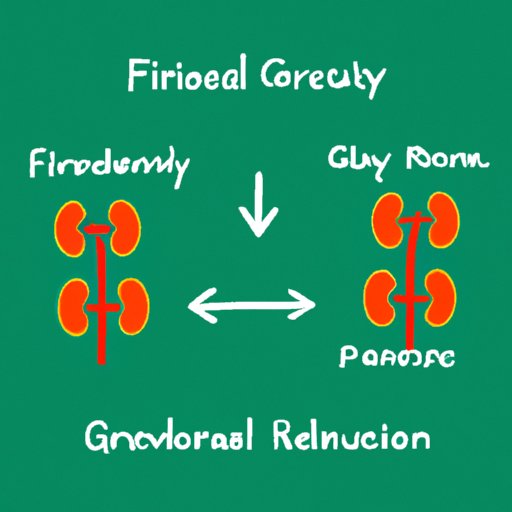Introduction
GFR (glomerular filtration rate) is a key indicator of kidney function and an important aspect of overall health. It measures your kidney’s ability to filter waste and excess fluids from the blood. In other words, it is a marker of how well your kidneys are working. The purpose of this article is to provide a comprehensive understanding of GFR, its normal range, and implications of deviations for overall health.
What is a normal GFR?
GFR is the volume of fluid that passes through the kidneys per minute. It is measured in mL/min. The normal range for GFR is between 90 and 120 mL/min. A value higher than 120 mL/min indicates possible hyperfiltration, while a value lower than 90 mL/min indicates possible kidney disease. If your GFR falls outside of the normal range, it can signify damage to your kidneys or dysfunction in your overall renal system.
GFR Test – How it’s Performed and What it Measures
GFR is typically measured with a blood test to determine the creatinine level and a urine test to determine the amount of creatinine being excreted in the urine. This information is used to calculate the GFR. The GFR test measures the amount of waste filtration in the kidneys. A low GFR indicates that the kidneys are not working properly and can potentially lead to kidney disease. Physicians use this test to diagnose kidney injury, monitor kidney dysfunction, and assess the severity of kidney disease.
Factors That Affect GFR
Age, sex, and overall health can affect the GFR. As you age, your GFR tends to decrease as the number of functioning nephrons in your kidneys decreases. Maintenance of a healthy body weight, keeping hydrated, exercising regularly, and following a healthy diet can help maintain your kidneys’ good health. Certain medical conditions, such as hypertension, cardiovascular disease, and diabetes, can impact the kidneys’ functioning, posing a risk for kidney injury and reduced GFR levels. Certain medications, including pain relievers, can also impact GFR levels.
Calculating GFR – Methods and Pros/Cons
Two methods are used to calculate GFR: serum creatinine-based equations and newer, more sophisticated tests like the iohexol clearance test. The creatinine-based equations are less expensive but less accurate than iohexol tests. The iohexol tests involve injection, multiple blood withdrawals, and expensive testing equipment, but provide more accuracy and precision. Each method has its pros and cons and is used in specific clinical settings.
GFR and Other Physiological Parameters
GFR is affected not only by kidney function but also other physiological parameters like blood pressure and blood glucose levels. High blood pressure is associated with a decrease in GFR, while lower glucose levels are associated with a higher GFR. Changes in GFR can lead to changes in blood pressure and blood glucose levels, impacting overall health and prognosis. When doctors assess individuals’ health, they carefully consider these interrelated factors.
Recent Research on GFR
Recent research suggests that maintaining stable blood glucose levels can improve GFR by reducing the stress on the kidneys. Traditional therapies for kidney disease have focussed only on treating the symptoms. New treatments have been introduced that target the underlying causes of kidney dysfunction and may improve GFR and reverse renal damage. These may include administering growth factors, cytokines, or stem cells specifically to the kidneys. Ongoing research in this field may lead to breakthroughs in reversing kidney disease.
Conclusion
GFR is a vital indicator of kidney function and overall health. A normal GFR range is between 90 and 120 mL/min. Factors like age, sex, overall health, medical conditions and medications, can affect GFR. By maintaining optimal kidney function through healthy habits and preventative care, individuals can help reduce the risk of kidney damage and dysfunction, improving their overall health. For those with reduced kidney function or kidney disease, new treatments offer hope for reversing the condition and improving overall health.
